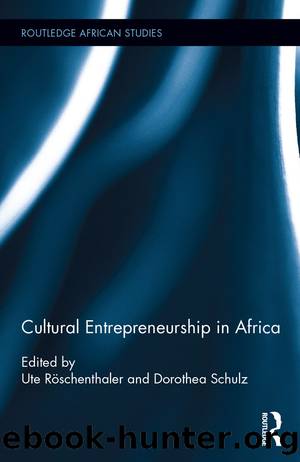Cultural Entrepreneurship in Africa by Ute Röschenthaler Dorothea Schulz

Author:Ute Röschenthaler, Dorothea Schulz [Ute Röschenthaler, Dorothea Schulz]
Language: eng
Format: epub
ISBN: 9780367870690
Barnesnoble:
Publisher: Taylor & Francis
Published: 2019-12-10T00:00:00+00:00
Notes
1.âThe terms written in italics are in tamajeq, the Tuareg language.
2.âKel azzaman literally means âthe people of todayâ. Kel eru means âthe people of the pastâ.
3.âAccording to the World Tourism Organization (2002), Africa only accounts for 4.1% of worldwide tourism. Within West Africa, Niger has an inferior market share of 0.2%.
4.âA package tour for three weeks in Niger costs up to $5,000.
5.âIndividual tourists make up only 15% of all tourists. This was different between the 1970s and the 1990s, when thousands of Europeans traveled with used cars through the desert to sell them in Niger. The violent conflicts in Algeria, the Tuareg rebellion in the 1990s, and the devaluation of the Franc CFA by 50% in 1994 brought the so-called âscrap metal tourismâ to an end.
6.âRhissa ag Boula retired from his office in 2004 when he was accused of involvement in the murder of a politician in northern Niger. He was imprisoned and released in 2005 without trial.
7.âA confederation is composed of several endogamous groups (tawshiten) of matrilineal descent.
8.âThe director of an agency needs to acquire sufficient material equipment, deposit a surety of 2 million FCFA (around $3,900), and pay annual fees of 500,000 FCFA ($970) and of 150,000 FCFA ($290) into a special state-owned development fund for tourism, among other payments and taxes.
9.âA driver-guide receives an average of 15,000 to 20,000 FCFA per day of traveling. A driver gets 6,000 to 7,500 FCFA per day just like a cook. A camel driver earns 5,000 and an aide 3,000 FCFA.
10.âSuch terminological analogies appear to be widespread among pastoralists in Africa. The Tswana in southern Africa, for example, speak of money as âcattle without legsâ (Comaroff and Comaroff 1991: 56).
11.âAll guides are drivers at the same time. The director of an agency will not hire a guide who cannot drive, as this would take up a seat in the car that could otherwise be sold to a tourist.
12.âIf the woman is older than her husband, then, according to local perception, she intends to rejuvenate herself through sexual intercourse.
13.âNoble patrons rarely exploited the smithsâeven before their impoverishment during the great droughts of the 1970s and 1980sâsince they had the right to protest in public against such an abuse, thus exposing their patrons as immoral.
14.âDiver-guides sometimes rent their own cars to the agency, making up to $6,300 per year whereas others do not earn more than $1,300.
15.âThe name shasturis stems from the French expression âchasser les touristsâ or âhunting touristsâ. Shasturis are predominantly young smiths and nobles who work as vendors of handicrafts and other objects (Scholze and Bartha 2004).
16.âAmong the shasturis are often also adolescent nobles who deliberately break the behavioral norms valid for their social layer when they act like smiths. The elder nobles tolerate this because of their young age and usefulness as commercial intermediaries.
17.âMano ag Dayak also exploited the myth to gain political and material support for the rebellion in the 1990s in western media (Decoudras 1995).
18.âSchool enrollment also contributes to the preference of not returning to camel herding and caravan trade.
Download
This site does not store any files on its server. We only index and link to content provided by other sites. Please contact the content providers to delete copyright contents if any and email us, we'll remove relevant links or contents immediately.
Focus Group Methodology by Pranee Liamputtong(494)
The Future Internet by Bernard Marr(465)
Python for Finance Cookbook by Lewinson Eryk;(456)
Empowering Public Speaking by Deanna L. Fasset & Keith Nainby(423)
Doing business with Japan : successful strategies for intercultural communication by Kazuo Nishiyama(406)
Global Orders and Civilizations : Perspectives from History, Philosophy and International Relations by Sadik Unay; Muzaffer Senel(336)
Engaging with Ethics in International Criminological Research by Michael Adorjan Rose Ricciardelli(307)
Intentional Power: The 6 Essential Leadership Skills For Triple Bottom Line Impact by Lisen Stromberg & JeanAnn Nichols & Corey Jones(276)
Analysis of Financial Statements by Frank J. Fabozzi & Frank J. Fabozzi(274)
The Three Skills of Top Trading by Hank Pruden(266)
The Economics of Banking by Jin Cao(263)
Entrepreneurial Marketing by unknow(255)
Focus on Teaching by Jim Knight(249)
The Oxford Handbook of Banking and Financial History by Youssef Cassis;Richard S. Grossman;Catherine R. Schenk;(247)
Building a Career in Cybersecurity: The Strategy and Skills You Need to Succeed by Yuri Diogenes(235)
Data Science and Analytics for SMEs: Consulting, Tools, Practical Use Cases by Afolabi Ibukun Tolulope(234)
New India by Arvind Panagariya(234)
Financial Statement Analysis by Martin S. Fridson;Fernando Alvarez; & Fernando Alvarez(228)
Maximum Success with LinkedIn by Dan Sherman(210)
